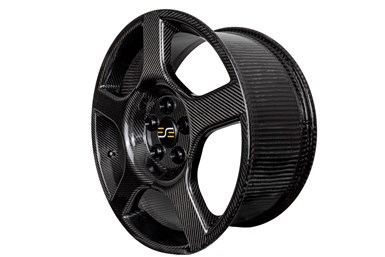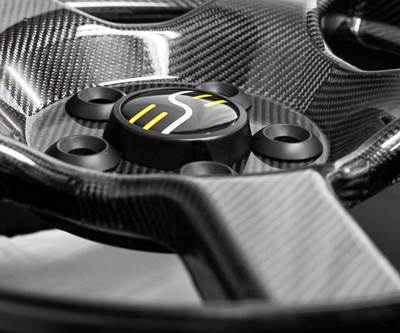ESE carbon fiber wheels launch to aftermarket segment
The E2 wheels, built from a combination of tailored fiber placement preforming with resin transfer molding, are available for select vehicles after passing stringent lab and field testing.

(ESE, Miami, Fla., U.S.) recently launched its E2 one-piece carbon fiber composite wheels into the market for the aftermarket segment. The initial E2 launch includes 19 x 8.5-inch wheels, servicing Tesla Model S, Tesla Model 3 and Subaru WRX STI vehicles.
The wheels, which CW wrote about in 2020, use tailored fiber placement (TFP) and high-pressure resin molding (RTM) to produce a lightweight, single-piece, high-performance wheel. Since CW last wrote about the wheels, ESE has completed its transition from initial autoclave processing to an improved RTM process using heated tooling. The resin and tooling are said to be preheated, with carefully controlled resin flow during infusion. Improvements have also been made to the TFP stitching process, to improve productivity as well as wheel mechanical properties. Small ply changes have been made to the E2s to ready them for market, to improve layup consistency, appearance and wheel test performance, and a clear coat solution has been finalized. The mounting hardware has also been refined to improve lug torque retention.
The wheels have been a four-year process to develop and test, ultimately passing stringent fatigue and impact tests set by the Society of Automotive Engineers’ (SAE) Recommended Practices for wheels.
According to ESE and , SAE recommended practices such as SAE J328 for vehicle wheels, SAE J2530 for aftermarket wheels, SAE J2562 for biaxial wheels, and SAE J175 for road vehicle wheels were originally designed to test traditional metal wheels. The E2s were able to pass all tests required of SAE, due to the wheels’ rigorous engineering analysis and testing during development, the company says.
Dr. Michael Hayes, ESE Carbon’s VP, head of engineering, served on an SAE committee in 2020 to develop new recommended practices specific to fiber-reinforced composite wheels.

The resulting SAE J3204 adapts the Recommended Practices for metal wheels to composite wheels, imposing new requirements such as strength reduction factors (SRFs) to account for environmental effects, maximum operating temperature testing, and electricity conductivity testing.
ESE emphasizes that its E2 wheels have also been proven to withstand impact at very cold temperatures, above and beyond the requirements. The company conducted its own independent lab testing to test curb and pothole impact at -40°C. The company says its wheels were not affected by the cold temperatures at all, thanks to specially developed wheel flanges designed with a high percentage of circumferentially oriented carbon fiber to maximize hoop strength. This strength is said to be great enough to enable the circumferential plies to be “nearly insensitive” to cold temperatures. “We have taken great care to design very robust flanges in our wheels,” Dr. Hayes explains. “In addition, because of the superior strength-to-weight ratio of carbon fiber composites, we can increase the size of the flanges to further increase impact strength without a weight penalty.” The TFP process allows for production of circular plies at a high fiber volume fraction.
See for more information.
Related Content
“Structured air” TPS safeguards composite structures
Powered by an 85% air/15% pure polyimide aerogel, Blueshift’s novel material system protects structures during transient thermal events from -200°C to beyond 2400°C for rockets, battery boxes and more.
Read MoreJEC World 2024 highlights: Glass fiber recycling, biocomposites and more
CW technical editor Hannah Mason discusses trends seen at this year’s JEC World trade show, including sustainability-focused technologies and commitments, the Paris Olympics amongst other topics.
Read MoreBraided thermoplastic composite H2 tanks with co-consolidated molded boss areas to fit EV battery space
BRYSON project demonstrates possible designs, automated manufacturing and low permeability concepts, including EVOH liner and novel PPA matrix.
Read MoreASCEND program completion: Transforming the U.K.'s high-rate composites manufacturing capability
GKN Aerospace, McLaren Automotive and U.K. partners chart the final chapter of the 4-year, £39.6 million ASCEND program, which accomplished significant progress in high-rate production, Industry 4.0 and sustainable composites manufacturing.
Read MoreRead Next
One-piece, one-cure, infused carbon fiber wheel is ready to roll
ESE Carbon Co.’s new carbon fiber wheel uses tailored fiber placement and custom presses to minimize waste and improve scalability.
Read MoreAll-recycled, needle-punched nonwoven CFRP slashes carbon footprint of Formula 2 seat
Dallara and Tenowo collaborate to produce a race-ready Formula 2 seat using recycled carbon fiber, reducing CO2 emissions by 97.5% compared to virgin materials.
Read MoreVIDEO: High-volume processing for fiberglass components
Cannon Ergos, a company specializing in high-ton presses and equipment for composites fabrication and plastics processing, displayed automotive and industrial components at CAMX 2024.
Read More.jpg;width=70;height=70;mode=crop)













